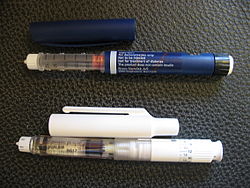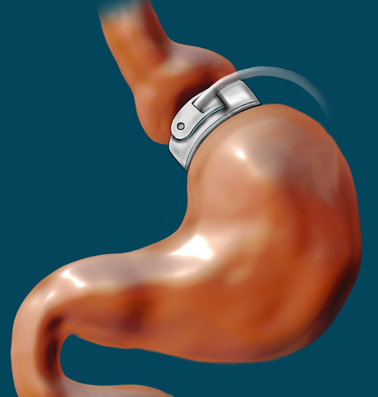Diabetes traetment
The treatment of diabetes mellitus differs fundamentally depending on the type of diabetes. Therefore, we will discuss the individual types of diabetes and their treatment separately.
Diabetes mellitus type I[edit | edit source]
In diabetes mellitus type I, due to autoimmune inflammation, the B-cells of the pancreat are gradually destroyed and thus the secretion of insulin disappears.
Insulin treatment[edit | edit source]
The treatment is carried out by exogenous supply of the missing insulin.
Dosage[edit | edit source]
The approximate endogenous secretion of insulin in a healthy 70 kg person is 40 IU/day. Of this amount, approximately half is accounted for by basal secretion, which is not affected by food intake, the other half of secretion is stimulated by food intake. Currently, for type I diabetics, the only correct regimen is intensified insulin therapy, which comes closest to physiological insulin secretion.
Intensified insulin therapy is a basal-bolus dosing regimen in which long-acting insulin is administered once daily (usually in the evening) to cover basal insulin needs, and short-acting insulin is administered in boluses before meals. The ratio of basal to short-acting insulin is approximately 50:50, but may vary depending on the type of insulin used.
Types of insulin[edit | edit source]
Depending on the duration of their action, insulins are divided into short-acting and long-acting. Short-acting: are used as boluses before meals. The onset of their effect is from 15 min. within 30 min. and the time of their maximum effect varies between 30 and 120 min. Long-acting: are used to cover the basal insulin requirement. They are applied either in one daily dose in the evening or in two doses in the morning and in the evening. The time of onset of their effect ranges from 50-120 min. and operates up to 24 hours Premixed insulins: contain a combination of short-acting and long-acting insulin. They are not used to treat type I DM.
We can further divide insulins into human insulins and insulin analogues. Insulin analogs have a more favorable pharmacokinetic profile compared to human insulins, their disadvantage is a higher price. The use of analogs is also not suitable during pregnancy.
Methods of insulin administration[edit | edit source]
The most widespread and simplest method of administration is administration using insulin pens. The most modern and physiological way is to administer insulin insulin pump. The pump allows administration of boluses before meals (the patient chooses the number of units according to what he is going to eat) in combination with continuous administration of the basal dose. Application using insulin syringes is no longer used. Intravenous administration of insulin is reserved for emergency situations only.
Non-pharmacological treatment[edit | edit source]
In patients with DM type I, emphasis is placed on controlled intake of carbohydrates. According to the expected carbohydrate intake, the patient chooses the number of boluse units before a meal. The effort is therefore to prevent large fluctuations in glycemia and to keep it within the optimal range. If the patient is taking human insulins, it is usually necessary to eat small snacks between meals to prevent hypoglycemia.
Type II diabetes mellitus[edit | edit source]
In the pathogenesis of diabetes II. type, the emergence of insulin resistance is applied significantly. The lack of insulin here is therefore not absolute as in type I diabetes, but relative. Therefore, in addition to insulin, we can also use drugs from the PAD (oral antidiabetics) group, which have a favorable effect especially on insulin resistance.
Oral antidiabetic drugs[edit | edit source]
Metformin[edit | edit source]
It is the drug of first choice in the treatment of diabetes II. type. It works on the principle of reducing insulin resistance and thus contributes to the reduction of fasting blood glucose in particular. It is used in a wide range of doses from 500 to 3000 mg. daily. Contraindications to its use are renal insufficiency with increased serum creatinine concentration above 135 μg/l and conditions with severe tissue hypoperfusion (e.g. heart failure), where the risk of lactic acidosis increases. Metformin must also be stopped 48 hours before surgery and the use of iodine contrast!
Sulfonylureas[edit | edit source]
They stimulate the secretion of insulin and thus primarily reduce postprandial glycemia. Their disadvantage is the risk of hypoglycemia and weight gain. They are therefore not the drug of first choice for obese diabetics, but are suitable in combination with metformin. The less frequently used glimepiride and gliclazide can also be used in patients with milder renal failure when the doses are reduced.
Glitazones[edit | edit source]
They increase insulin sensitivity by acting on nuclear receptors. Again, they are used in combination with metformin. An adverse effect is an increased incidence of heart failure and weight gain.
Incretins[edit | edit source]
They are the most modern of PAD. They work on the principle of increased insulin secretion, but only in hyperglycemia. In normoglycemia, it istheir effect does not apply, so unlike sulfonylureas, they do not cause hypoglycemia. There are two forms of administration. Oral dipeptidyl peptidase-4 (DPP4) inhibitors eg sitagliptin and the injectable GLP-1 agonist exenatide, which causes weight loss. Incretins are therefore particularly suitable in combination with metformin for the treatment of obese diabetics.
Insulin treatment[edit | edit source]
It has in diabetics II. type your specifics. Due to the presence of insulin resistance, the need for insulin can be expected to increase several times, so 40 IU is often not enough. At the same time, it is necessary to take into account the anabolic effect of insulin, which leads to weight gain, which is precisely the case with DM II. particularly inappropriate type. We combine insulin therapy with treatment with metformin, which we therefore do not discontinue for patients.
Basal insulin administration[edit | edit source]
It is the simplest regimen, which consists of the application of long-acting insulin once a day in the evening. The goal is to reduce fasting hyperglycemia.
Application of premixed insulins[edit | edit source]
It is advantageous because, in addition to fasting hyperglycemia, it also affects postprandial hyperglycemia. Premixed insulin is applied twice a day before breakfast and before dinner.
Intensified insulin therapy[edit | edit source]
As with type I DM, the basal-bolus system is used. We approach this mode only after exhausting other options.
Non-pharmacological treatment[edit | edit source]
It has in diabetics II. type of eminent importance. A change in lifestyle can reverse the development of the disease and lead to the disappearance of diabetes.
Diet[edit | edit source]
It is reducing for most diabetics with the aim of achieving weight reduction of 5-10%. Particular emphasis is placed on limiting the intake of free carbohydrates, cholesterol and animal fats. Dia foods are unsuitable in most cases because they are more caloric.
Physical activity[edit | edit source]
It is an integral part of the treatment and should be operated for at least 30 min. 4 times a week. It not only supports weight loss, but also has a beneficial effect on other cardiovascular risk factors (high blood pressure, lipids).
Bariatric treatment[edit | edit source]
It is undoubtedly a promising treatment modality in diabetology. In obese diabetics who are difficult to compensate with standard treatment, it brings success in 70 to 90%, depending on the type of operation used. There is either a significant improvement in compensation or even a complete disappearance of diabetes. According to the current criteria, a diabetic with BMI above 35 kg/m² is indicated for bariatric surgery.
Links[edit | edit source]
Related Articles[edit | edit source]
Literature[edit | edit source]
- ČEŠKA, R.. Interna. 1. edition. Triton, 2010. ISBN 978-80-247-2393-8.



